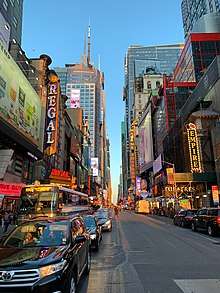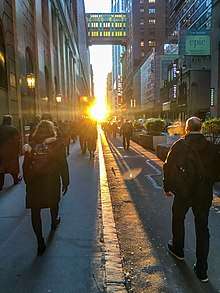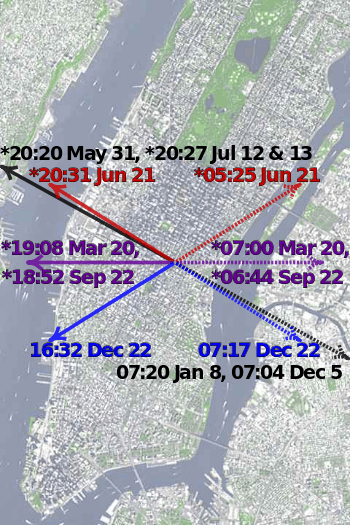Manhattanhenge
Manhattanhenge, also called the Manhattan Solstice,[1] is an event during which the setting sun or the rising sun is aligned with the east–west streets of the main street grid of Manhattan, New York City. The sunsets and sunrises each align twice a year, on dates evenly spaced around the summer solstice and winter solstice. The sunset alignments occur around May 28 and July 13. The sunrise alignments occur around December 5 and January 8. Excellent places for viewing Manhattanhenge are 14th, 23rd, 34th, 42nd, and 57th Streets.[2]

Explanation and details
The term Manhattanhenge was coined by Neil deGrasse Tyson,[3] an astrophysicist at the American Museum of Natural History and a native New Yorker. It is a reference to Stonehenge, a prehistoric monument located in Wiltshire, England, which was constructed so that the rising sun, seen from the center of the monument at the time of the summer solstice, aligns with the outer "Heel Stone".[4][5] In an interview, Tyson stated that the name was inspired by a childhood visit to Stonehenge on an expedition headed by Gerald Hawkins, an astronomer who was the first to propose Stonehenge's purpose as an ancient astronomical observatory used to predict movements of sun and stars, as outlined in his 1965 book Stonehenge Decoded. According to Tyson,
I visited Stonehenge as a kid at age 15 on an expedition that [Hawkins] was the expedition head... and that stuck with me, which is why I named this phenomenon in Manhattan where the sun sets along the street grid... I named that Manhattanhenge, sort of harkening back to my early days thinking about the alignment of the sun and structures that we might build."[6]
In accordance with the Commissioners' Plan of 1811, the street grid for most of Manhattan is rotated 29° clockwise from true east–west.[7] Thus, when the azimuth for sunset is 299° (i.e., 29° north of due West), the sunset aligns with the streets on that grid. This rectilinear grid design runs from north of Houston Street in Lower Manhattan to south of 155th Street (Manhattan) in Upper Manhattan.[8] A more impressive visual spectacle, and the one commonly referred to as Manhattanhenge, occurs a couple of days after the first such date of the year, and a couple of days before the second date, when a pedestrian looking down the centerline of the street westward toward New Jersey can see the full solar disk slightly above the horizon and in between the profiles of the buildings.[1] The date shifts are due to the sunset time being when the last of the sun just disappears below the horizon.
The precise dates of Manhattanhenge depend on the date of the summer solstice, which varies from year to year, but remains close to June 21. In 2014, the "full sun" Manhattanhenge occurred on May 30 at 8:18 p.m., and on July 11 at 8:24 p.m.[4] The event has attracted increasing attention in recent years.[9]
The dates on which sunrise aligns with the streets on the Manhattan grid are evenly spaced around the winter solstice, and correspond approximately to December 5 and January 8.[10]
Occurrences



In the following table, "full sun" refers to occurrences of the full solar disk just above the horizon, and "half sun" refers to occurrences of the solar disk partially hidden below the horizon.[4]
| Date | Time | Type |
|---|---|---|
| May 29, 2016 | 8:12 p.m. | Half sun[11] |
| May 30, 2016 | 8:12 p.m. | Full sun[11] |
| July 11, 2016 | 8:20 p.m. | Full sun[11] |
| July 12, 2016 | 8:20 p.m. | Half sun[11] |
| May 29, 2017 | 8:13 p.m. | Half sun[12] |
| May 30, 2017 | 8:12 p.m. | Full sun[12] |
| July 12, 2017 | 8:20 p.m. | Full sun[12] |
| July 13, 2017 | 8:21 p.m. | Half sun[12] |
| May 29, 2018 | 8:13 p.m. | Half sun[4] |
| May 30, 2018 | 8:12 p.m. | Full sun[4] |
| July 12, 2018 | 8:20 p.m. | Full sun[4] |
| July 13, 2018 | 8:21 p.m. | Half sun[4] |
| May 29, 2019 | 8:13 p.m. | Half sun[4] |
| May 30, 2019 | 8:12 p.m. | Full sun[4] |
| July 12, 2019 | 8:20 p.m. | Full sun[4] |
| July 13, 2019 | 8:21 p.m. | Half sun[4] |
| May 29, 2020 | 8:13 p.m. | Half sun[4] |
| May 30, 2020 | 8:14 p.m. | Full sun[4] |
| July 11, 2020 | 8:20 p.m. | Full sun[4] |
| July 12, 2020 | 8:21 p.m. | Half sun[4] |
Related phenomena in other cities
The same phenomenon happens in other cities with a uniform street grid and an unobstructed view of the horizon. If the streets on the grid were rigorously north–south and east–west, then both sunrise and sunset would be aligned on the days of the vernal and autumnal equinoxes (which occur around March 20 and September 23 respectively). In Baltimore, for instance, sunrise aligns on March 25 and September 18 and sunset on March 12 and September 29.[13] In Chicago, the setting sun lines up with the grid system on March 20 and September 25, a phenomenon dubbed Chicagohenge.[14]
In Toronto, the setting sun lines up with the east–west streets on February 16 and October 25, a phenomenon now known locally as Torontohenge.[15] In Montreal, there may be a Montrealhenge each year around June 12.[16]
When the architects designing the city center of Milton Keynes, in the United Kingdom, discovered that its main street almost framed the rising sun on Midsummer Day and the setting sun on Midwinter Day, they consulted Greenwich Observatory to obtain the exact angle required at their latitude, and persuaded their engineers to shift the grid of roads a few degrees.[17]
In Cambridge, Massachusetts, MIThenge occurs about January 11 and November 29, when the setting sun may be seen across the length of the "Infinite Corridor", at the Massachusetts Institute of Technology.[18]
See also
- Stonehenge replicas and derivatives
- Street canyon
References
- Jenkins, Alejandro (2013). "The Sun's position in the sky". European Journal of Physics. 34 (3): 633. arXiv:1208.1043. Bibcode:2013EJPh...34..633J. doi:10.1088/0143-0807/34/3/633.
- "Manhattanhenge 2020". rove.me.
- Iezzi, Teressa (May 29, 2015). "How Neil deGrasse Tyson Discovered Manhattanhenge". Fast Company.
- Tyson, Neil deGrasse. "Manhattanhenge" on the Hayden Planetarium website
- Lee, Jennifer 8. (June 1, 2009). "Manhattanhenge". City Room. New York Times. Retrieved July 9, 2017.
- "Joe Rogan Experience #1159 - Neil deGrasse Tyson" (Video Interview). YouTube. 1:07:29: Joe Rogan Experience. August 22, 2018. Retrieved August 31, 2018.CS1 maint: location (link)
- Petzold, Charles. "How Far from True North are the Avenues of Manhattan?". Archived from the original on April 4, 2007. Retrieved July 9, 2017.
- "The Story of 'Manhattanhenge': An NYC Phenomenon Explained". space.com.
- LaFrance, Adrienne (May 29, 2014). "Why Do People Love Manhattanhenge So Much?". The Atlantic. Retrieved July 14, 2014.
- "Sun to strike New York streets in 'Manhattanhenge'". The Daily Telegraph. July 11, 2011.
In wintertime, the phenomenon is seen around December 5 and January 8.
- Carlson, Jen (May 6, 2016). "Here Are Your 2016 Manhattanhenge Dates". Gothamist. Archived from the original on May 9, 2016. Retrieved May 12, 2016.
- Carlson, Jen (May 15, 2017). "Here Are Your 2017 Manhattanhenge Dates". Gothamist. Archived from the original on May 17, 2017. Retrieved May 17, 2017.
- "Baltimore Sun: Baltimore breaking news, sports, business, entertainment, weather and traffic". Baltimore Sun. July 13, 2007.
- Moser, Whet (August 20, 2009). "Chicagohenge!". Chicago Reader. Retrieved September 20, 2010.
- Watson, Gavan (July 7, 2009). "Experience "Manhattanhenge" in Toronto". Gavan P. L. Watson.
- DeWolf, Christopher (July 14, 2009). "Manhattanhenge and Montrealhenge". urbanphoto.com. Retrieved September 18, 2016.
- Barkham, Patrick (May 3, 2016). "The struggle for the soul of Milton Keynes". Retrieved May 11, 2016.
- Goldman, Stuart J. (November 2003). "Sun Worship in Cambridge" (PDF). Sky & Telescope. Archived from the original (PDF) on March 4, 2016. Retrieved July 17, 2014.
External links
| Wikimedia Commons has media related to Manhattanhenge. |
Media
- Flickr photos tagged with Manhattanhenge
- Video interpretation of Manhattanhenge
- Video on Science Friday website
- Manhattanhenge, NOVA scienceNOW, first broadcast September 14, 2006
